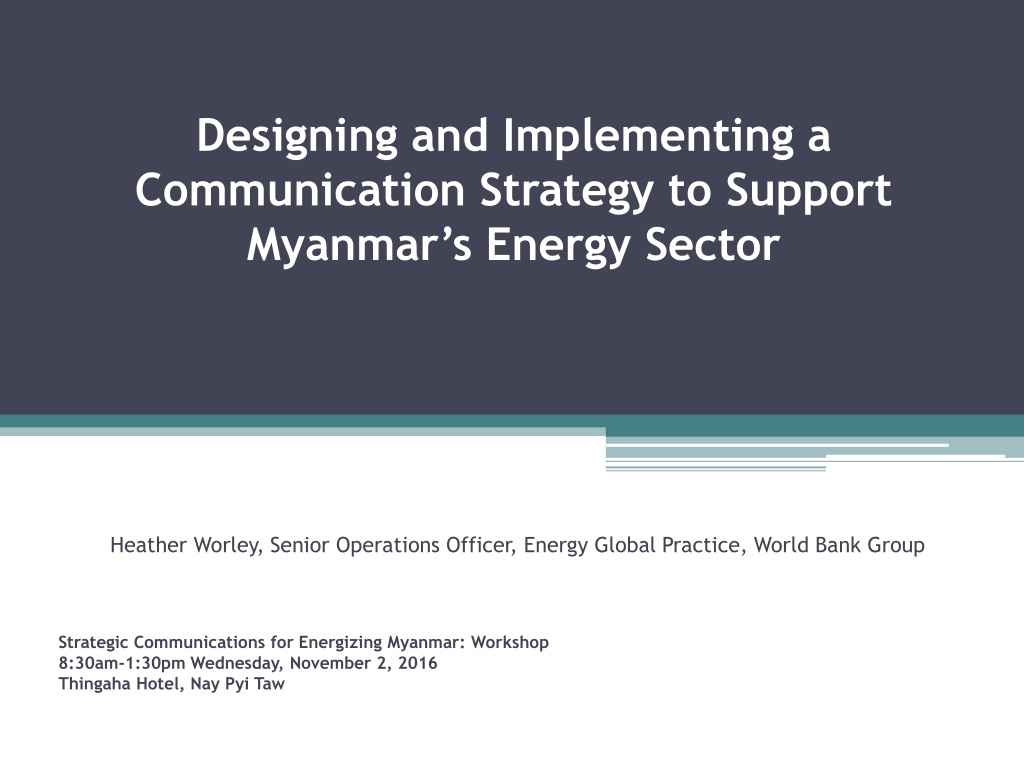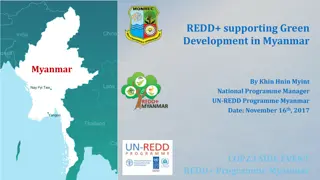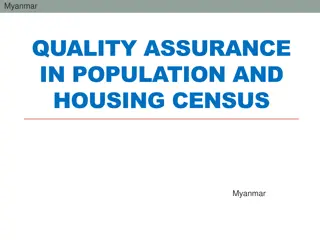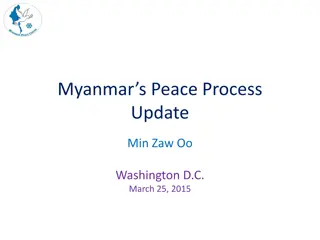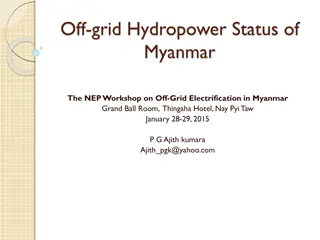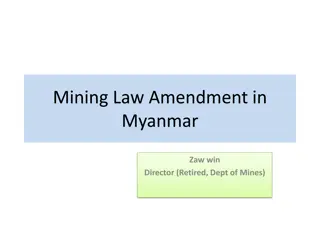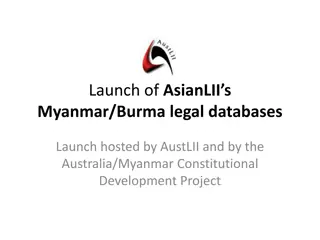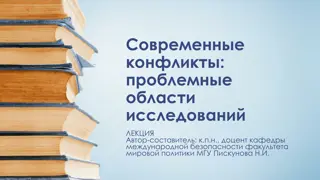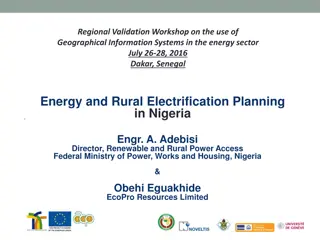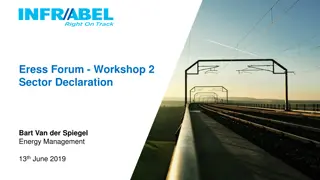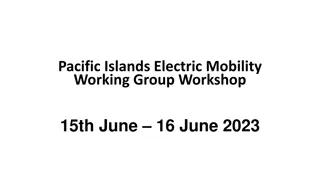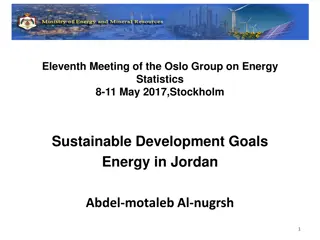Strategic Communication Workshop for Myanmar's Energy Sector
Heather Worley, a Senior Operations Officer at the World Bank Group, leads a workshop on designing and implementing a communication strategy to support Myanmar's energy sector. The session covers researching attitudes and behaviors, crafting compelling messages, and engaging audiences effectively. Key insights include understanding audience motivations, utilizing pledges and social incentives, and focusing on what the audience hears. Practical steps in strategy design involve conducting opinion research, setting objectives, messaging, selecting channels, identifying spokespersons, budgeting, goal-setting, and planning tactics.
Download Presentation

Please find below an Image/Link to download the presentation.
The content on the website is provided AS IS for your information and personal use only. It may not be sold, licensed, or shared on other websites without obtaining consent from the author. Download presentation by click this link. If you encounter any issues during the download, it is possible that the publisher has removed the file from their server.
E N D
Presentation Transcript
Designing and Implementing a Communication Strategy to Support Myanmar s Energy Sector Heather Worley, Senior Operations Officer, Energy Global Practice, World Bank Group Strategic Communications for Energizing Myanmar: Workshop 8:30am-1:30pm Wednesday, November 2, 2016 Thingaha Hotel, Nay Pyi Taw
Overview of session: Present research on communicating to change attitudes and behaviour Discuss the process of designing and implementing a communications strategy Discuss the importance (and How-to) of compelling messages that resonate with your audience
Communication for attitudinal change: Interactive process with citizens and communities to build goodwill and promote positive behaviors. Based on proven theories of human decision making and designed to enable people to initiate and sustain positive behavior outcomes. Begins with research on opinions and social norms, followed by communication planning, implementation, and monitoring and evaluation. Audiences are segmented, messages and materials are pre- tested, and channels are chosen for optimal reach.
Research shows: Understanding what motivates people and drives their behaviour is central to successful policy-making People will work harder to reinforce their existing positions than they will to change their minds People place more weight on the short-term than on the long-term effects of their decisions When people have something to lose they are more inclined to do something to prevent the loss Pledges can help people act on their good intentions Social incentives can be as effective as economic incentives
Its not what you say, it s what your audience hears.
Designing and implementing a strategy: Conduct opinion research (What does our audience think/feel?) Determine objectives (What do we want our audience to think/do?) Design compelling messages (What do we want people to know/feel?) Identify optimal channels (Where do people get trusted information?) Assign spokespeople (Who is a credible deliverer of our messages?) Determine a timeline and budget Design tactics (What do we need to do to encourage/inform dialogue?) Set measurable goals (How will we know if we are succeeding?)
What do citizens think about energy in Myanmar? Opinion surveys In-depth interviews Focus groups Literature and media review Stakeholder mapping Desk review of other agencies opinion research You should have a solid understanding of public opinion before you design a communication strategy.
Survey findings Jobs and high prices are top public concerns Energy sector seen as heading in the right direction, especially with regards to availability of electricity, but public concerned most about high energy prices A broad awareness and approval of energy reforms Personal responsibility regarding theft: stealing of electricity is frequent and getting worse, leading to significant impact on prices Personal responsibility regarding energy savings: energy saving efforts getting worse, though most people are concerned about personal savings Most respondents have heard about the government s energy sector reforms; support weaker for privatization process Privatization support is driven by energy reliability; but concerns about jobs losses
Jobs and high prices are top concerns Now, I am going to read you a list of concerns that some people may have. Please tell me which TWO of these are the most important for the government to address. 46 Jobs and unemployment 40 High prices 34 Corruption 25 Poverty 15 Energy issues 12 Health care 11 Crime 6 Education 5 Environmental issues 2 Relations with neighboring countries % 0 10 20 30 40 50
Energy sector heading in the right direction Generally speaking, do you think that the energy sector in Kosovo is going in the right direction, or do you feel the energy sector in Kosovo is going in the wrong direction? Right direction, strongly Right direction, somewhat 60 51 % 38% 40 20 16% 6% 0
Prices dominate energy concerns Now, I am going to read you a list of concerns that some people may have about the energy sector in Kosovo. Please tell me which TWO of these concern you the most. 56 High energy prices 25 Corruption within the energy sector 22 The digital electricity meters 22 Air pollution caused by using coal 16 The stealing of electricity by the public 16 Reliability of electricity supply 13 Privatization of Kosovo's energy companies 11 Neighbor countries' involve in energy affairs 3 The public's lack of energy-saving efforts 3 Lack of renewable energy use % 0 20 40 60
Energy saving efforts seen as getting worse Now I will read you a list of issues concerning the energy sector in Kosovo. Please tell me if you think Kosovar citizens energy saving efforts is getting better or worse in Kosovo. Much better Somewhat better Much worse Somewhat worse 60 51% 38% 40 20 22% 13% 0 Better Worse
Most concerned about personal energy savings Are you very concerned, somewhat concerned, a little concerned, or not at all concerned about saving energy in your home and place of work? 88 % 80 64% 60 40 24% 20 4% 7% 0 Very concerned Somewhat concerned A little concerned Not at all concerned
Awareness of governments energy efficiency outreach Have you seen information from the government in recent weeks on energy efficiency? 60 55% 40 24% 20 2% 7% 6% 5% Yes, from friends or family 0 Yes, on TV Yes, in a newspaper Yes, on the radio No Don't know/Refused
Energy saving techniques What specific energy savings techniques are you most likely to use within your own household, if you use any at all? 82 Turn off lights in unused rooms 69 Use a wood-burning stove 64 Install energy-efficient light bulbs 56 Only turn on water boiler when needed Use electricity only during the low-tariff periods 43 Use alternative energy means, like heating water in the sun 22 % 0 20 40 60 80 100
Designing and implementing a strategy: Conduct opinion research (What does our audience think/feel?) Determine objectives (What do we want our audience to think/do?) Design compelling messages (What do we want people to know/feel?) Identify optimal channels (Where do people get trusted information?) Assign spokespeople (Who is a credible deliverer of our messages?) Determine a timeline and budget Design tactics (What do we need to do to encourage/inform dialogue?) Set measurable goals (How will we know if we are succeeding?)
What do we want our audience to think/do differently? Objectives should be specific, achievable, and measurable Agreement should be reached among agencies about goals One year from now what attitudes would we like to see? Identify informational and attitudinal objectives
Example of setting objectives AdCouncil partnered with US Department of Energy on a campaign to demonstrate that energy efficient actions can reduce household energy bills Research showed 79% of surveyed parents believed the #1 reason to save energy in the home was to save money Objectives from 2011-2012 were to: Drive traffic to energysavers.gov website for helpful tips Encourage people to purchase Energy Star appliances Promote household insulation Encourage home energy audits
Example of meeting objectives More people bought Energy Star appliances (53% v 60%), added insulation (24% v 28%), and did home energy audits (18% v 21%). More people believed it is not hard to save energy (61% v 67%). People were more likely to say they did things to save energy often (44% v 49%). Almost one in five homeowners (17%) recognized at least one PSA. Ad-aware respondents more likely to say that saving energy is extremely important (48% v 36%), that they do things to save money in the home often (58% v 47%), did a home energy audit (13% v 7%), and had saved electricity as a way to save money. They were more likely to have visited a website to get more information about how to save energy in the home (23% v 12%), and to have said they changed a light bulb in order to get more energy efficiency (73% v 51%).
Often, resistance to change is caused by confusion rather than opposition.
Designing and implementing a strategy: Conduct opinion research (What does our audience think/feel?) Determine objectives (What do we want our audience to think/do?) Design compelling messages (What do we want people to know/feel?) Identify optimal channels (Where do people get trusted information?) Assign spokespeople (Who is a credible deliverer of our messages?) Determine a timeline and budget Design tactics (What do we need to do to encourage/inform dialogue?) Set measurable goals (How will we know if we are succeeding?)
What do we want people to know/feel? Develop clear, concise messages that are relevant to people s lives Messages should be relevant, unique, and repetitive Appeal to principles equality, individualism, ideals about government, patriotism, frugality Source credibility and trust are key to receptivity your choice of spokesperson can make or break a campaign.
Example of message testing For each phrase, I'd like for you to tell me how much more favorable that phrase makes you feel towards the government's energy reforms - does it make you feel much more favorable, somewhat more favorable, just a little more favorable, or no difference? Much more favorable Somewhat more favorable A Reliable, Cleaner Energy Using Energy Wisely Creating Jobs with Energy Modern Energy, Modern Kosovo Energy for the Future Energy for Development Healthy Energy, Strong Kosovo Power for an Independent Kosovo* Kosovo Energy 0 20 40 60 80 100 %
Messages shift support toward governments reforms Now let me ask you again. Based on what you know, do you think the government's energy reforms will have a mostly positive or mostly negative impact on average Kosovars? Based on what you know, do you think the government's energy reforms will have a mostly positive or mostly negative impact on average Kosovars? 80 +8 64 60 56 40 25 20 18 0 Positive Negative Positive Negative % Page 25
Message checklist Simple Concrete Credible Emotional Story
Designing and implementing a strategy: Conduct opinion research (What does our audience think/feel?) Determine objectives (What do we want our audience to think/do?) Design compelling messages (What do we want people to know/feel?) Identify optimal channels (Where do people get trusted information?) Assign spokespeople (Who is a credible deliverer of our messages?) Determine a timeline and budget Design tactics (What do we need to do to encourage/inform dialogue?) Set measurable goals (How will we know if we are succeeding?)
Where do people get trusted information? What is your main source of information for news? 82 Television 5 Internet 5 Radio 3 Newspaper Other 2 Word of mouth 2 0 20 40 60 80 100 %
SMS messages will have a wide reach Do you have a telephone in your home - either a home phone or a mobile phone? 89% mobile 80 67 60 40 20 22 5 5 0 Home phone only Mobile phone only Home and separate mobile phone No phone %
Designing and implementing a strategy: Conduct opinion research (What does our audience think/feel?) Determine objectives (What do we want our audience to think/do?) Design compelling messages (What do we want people to know/feel?) Identify optimal channels (Where do people get trusted information?) Assign spokespeople (Who is a credible deliverer of our messages?) Determine a timeline and budget Design tactics (What do we need to do to encourage/inform dialogue?) Set measurable goals (How will we know if we are succeeding?)
Example of a timeline preparation phase SUNDAY MONDAY TUESDAY WEDNESDAY 20-Mar THURSDAY 21-Mar FRIDAY SATURDAY 17-Mar 18-Mar 19-Mar 22-Mar 23-Mar PRESENT COMMUNICATION PLAN & CONDUCT WORKSHOPS 24-Mar 25-Mar 26-Mar 27-Mar 28-Mar 29-Mar MED releases bid for new Kosovo e Re transaction monitor 30-Mar DEVELOP SOCIAL MEDIA CAMPAIGN & UPDATE WEBPAGES 31-Mar 1-Apr 2-Apr 3-Apr 4-Apr 5-Apr 6-Apr HIRE AD FIRM: WRITE AD SCRIPTS AND DEVELOP PRINT ADS 7-Apr 8-Apr 9-Apr 10-Apr 11-Apr 12-Apr 13-Apr DEVELOP AND WRITE WHITE PAPERS ON REFORMS 14-Apr 15-Apr 16-Apr 17-Apr 18-Apr 19-Apr 20-Apr ORGANIZE, SET UP, PLAN EVENTS FOR LAUNCH WEEK Dates shown assume a launch week of April 22
Example of a timeline campaign phase SUNDAY MONDAY TUESDAY WEDNESDAY 24-Apr THURSDAY 25-Apr FRIDAY SATURDAY 21-Apr 22-Apr 23-Apr 26-Apr 27-Apr WEEK ONE: CAMPAIGN LAUNCH 28-Apr 29-Apr 30-Apr 1-May RenewableEnergy and Energy Efficiency Policy Papers are released 2-May 3-May KEDS transfers to Limak-Calik 4-May WEEK TWO: OPENING NEW INVESTMENT 5-May 6-May 7-May 8-May 9-May 10-May 11-May WEEK THREE: REDUCING PRICES 12-May 13-May 14-May MED/WB/EC donor conferences on Sustainable Energy for Kosovo 15-May 16-May 17-May 18-May WEEK FOUR: CREATING JOBS & BRINGING INVESTMENT Dates shown assume a launch week of April 22
Designing and implementing a strategy: Conduct opinion research (What does our audience think/feel?) Determine objectives (What do we want our audience to think/do?) Design compelling messages (What do we want people to know/feel?) Identify optimal channels (Where do people get trusted information?) Assign spokespeople (Who is a credible deliverer of our messages?) Determine a timeline and budget Design tactics (What do we need to do to encourage/inform dialogue?) Set measurable goals (How will we know if we are succeeding?)
Designing and implementing tactical activities Be opportunistic and creative Look at your calendar and plan high-impact communications activities, including a Central Campaign Action Disciplined implementation is critical It s easy to write a communications strategy that looks persuasive on paper but implementing the strategy is a very different task and requires consistent attention Assess progress and changing circumstances regularly, don t be afraid to tweak as necessary Messages often drive tactical ideas
Designing and implementing a strategy: Conduct opinion research (What does our audience think/feel?) Determine objectives (What do we want our audience to think/do?) Design compelling messages (What do we want people to know/feel?) Identify optimal channels (Where do people get trusted information?) Assign spokespeople (Who is a credible deliverer of our messages?) Determine a timeline and budget Design tactics (What do we need to do to encourage/inform dialogue?) Set measurable goals (How will we know if we are succeeding?)
Setting measurable goals Test awareness levels during survey or focus groups Identify indicators before you begin implementing the strategy (appliances sold, insulated homes, visits to energy efficiency website, amount of energy used) Outcomes: what happened as a result of what you did? Are people changing their behaviours? Outputs: actions that have been taken by your communications team, events held, tactical activities. Revisit your research: have opinions changed? Conduct a second survey after the campaign to (1) re-measure awareness levels; (2) track exposure to messages; (3) determine the reach and influence of your communication strategy
Draft Example of Setting Goals India: Educational Campaigns Participation 23,000 2014-15 50,000 2015-16 School Level Interventions Painting and Essay writing Competitions Over 118,000 subscribers on Facebook India International Trade Fair & Oil & Gas Conservation Fortnight - Events, Exhibitions, Stalls, Games, Puzzles, Word hunt Reached 4.8 million users through 45,000 fuel stations Raahgiri - Nukkad Natak (Street plays), Slow Cycling Competitions, Pledge writing, Demonstration of particulate matter (measurements) at crossings and fuel stations 9 May 2016 PwC
Draft Results of the Indian Educational Campaigns Annual post-campaign survey to measure shifts in behavior, attitudes of end users Quantitative analysis of the savings accrued by raising awareness An impact assessment study conducted for the year 2013 14 demonstrated that mass awareness campaigns resulted in estimated fuel savings of 567,375 MT of petrol, 1,873,083 MT of diesel, and 948,383 MT of LPG. These savings will reduce carbon dioxide emissions into the atmosphere by approx. 9.10 million MT Source: Petroleum Conservation Research Association, India 9 May 2016 PwC
A communication strategy is a process, not a document Requires an up-to-date understanding of public opinion and stakeholders needs Requires prioritisation and choices May have informational and attitudinal goals that require specific compelling messages May change along the way if political circumstances change, requires a nimble team
Thank you Questions and Discussion hworley@worldbank.org
